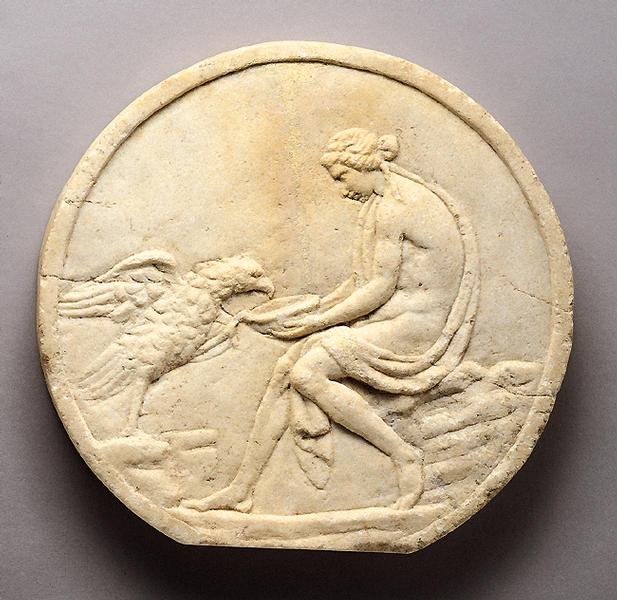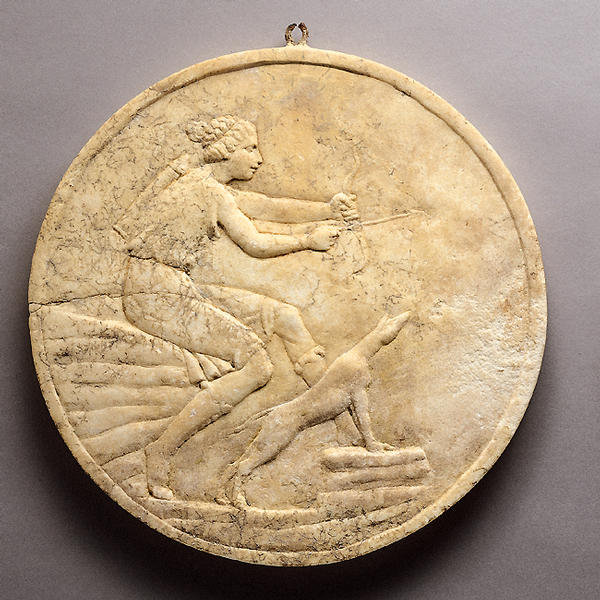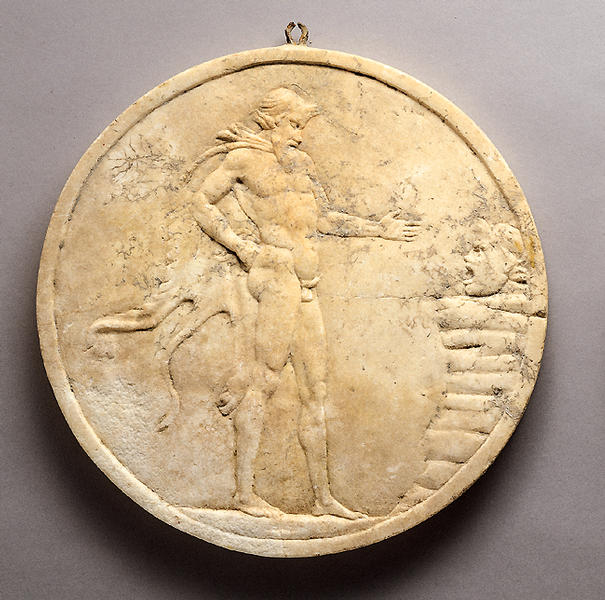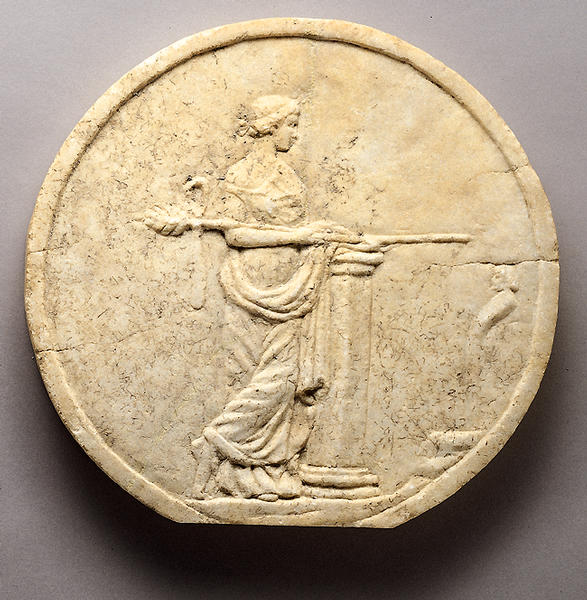オッシラ
- ローマ
- ローマ
- 1世紀
- 大理石
- D-34
ローマの標準的な邸宅には列柱式庭園に白色の大理石や鮮やかな色の石で作った様々なタイプの装飾彫刻で荘厳されていた。それは、柱と柱の間に一つというという原則で水平の梁にロープのようなもので吊るされていた。オッシラとは「揺れる」という意味で、大理石製のマスクや浮き彫りを表裏に施したものをいう。2ーbは、獣の毛皮を巻き付けた有髭のサチュロスが立ち、岩の路頭に置かれた演劇用の仮面に左手を差し出し何かを語りかけているような場面が描かれている。その裏面は、キトーンと長い靴を履いた若いアルミテスが岩の上に腰を下ろし、弓矢を持って画面の外にいるはずの獲物に狙いを定めようとしている。彼女の足下の猟犬は、体を乗り出して獲物の臭いを嗅いでいる。1ーaは、正装したディオニュソスの従者の女性が右手にテュルソス(杖)を持って、柱にもたれ掛かった姿が描かれている。前方には小さなヘルメ柱(ヘルメース神の頭部)が置かれている。裏面には、若い半裸のガニュメーデースが、鷲に変身したゼウス神の喉の渇きを癒すべく、水の入った鉢を差し出している光景が描かれている。これらの主題は他の作品にも頻繁に見られるものである。
Catalogue Entry
The peristyle gardens of Roman houses typically were embellished with a wide variety of decorative sculptures of white marble or colored stone. Most of our evidence for the original appearance of these gardens, as well as the kind of sculpture they housed, comes from the excavations at Pompeii and other Vesuvian sites destroyed in the eruption of A.D. 79.1 Carved marble circular reliefs with figural scenes on both sides are most prevalent in Pompeii and its environs, but they also occurred with some frequency elsewhere in the Roman world, including the western provinces and North Africa. What is evident, however, is that they were not as common in Greece and Asia Minor.
Figural tondi belong to a class of decorative sculpture known as oscilla (after a passage in Virgil's Georgics) 2--namely, marble masks and double reliefs of various shapes used as architectural decoration in Roman peristyles and especially gardens. They were suspended from architraves, one oscillum to each intercolumniation. Tondo A preserves the iron hook used to hang the sculpture, whereas the standard metal ring is missing from tondo B, 3 which is not completely circular in shape, but has a smooth, straight edge at the bottom--an unusual and puzzling feature that perhaps is the result of an ancient repair. Sculptured tondi are the most usual form of Roman oscilla, the majority of which can be assigned to the first century A.D. It has been suggested that the iconography of the entire class corresponds to the dramatis personae of ancient drama, 4 but whether or not that is the case, the overall effect of these sculptures is somewhat repetitive, if highly decorative. In addition, obvious points of contact exist with the thematic repertoire of the so-called neo-Attic reliefs of the Late Hellenistic and Roman Imperial periods. 5
On one side of tondo A is a standing, bearded satyr wearing an animal's skin tied around his neck and gesturing toward a theater mask that is positioned atop a rocky outcrop. 6 On the reverse, a youthful Artemis wearing a chiton and tall boots sits on a rock and aims her arrow at a target outside the frame. Her hound, at her feet, leans forward, sniffing the air. Tondo B likewise juxtaposes a generic Dionysiac figure shown standing and a specific deity depicted seated on a rock. This time, a fully draped maenad holds a thyrsus with her right hand as she leans against a stepped pillar in front of which a small herm is placed. The other side of the sculpture features a youthful, semidraped Ganymede holding out a bowl to a thirsty and eager Zeus, who has transformed himself into an eagle. This particular composition is well attested in representations in other mediums, especially Roman gems. 7
CAP
1. For the most recent, comprehensive account see Jashemski 1979 and 1993.
2. Georgics II, 11. 385-89. On oscilla see Corswandt 1982; and Dwyer 1981, pp. 247-306, pls. 80-130; the two authors do not agree on the chronological sequence of the sculptures. See also Dwyer 1982.
3. The marble in the area of the iron hook broke away and has been restored with modern plaster.
4. See Dwyer 1981, p. 249.
5. On neo-Attic workshops see, most recently, Smith 1991, pp. 258-61, 282 (references).
6. For a very similar scene on an oscillum in Herculaneum see Corswandt 1982, p. 77, no. K27, pl. 18:2.
7. See Herbig 1949, pp. 1-9; see also LIMC 4 (1988), s.v. Ganymedes (by Hellmut Sichtermann), esp. pp. 161-62, nos. 138-69, pls. 86-88.



